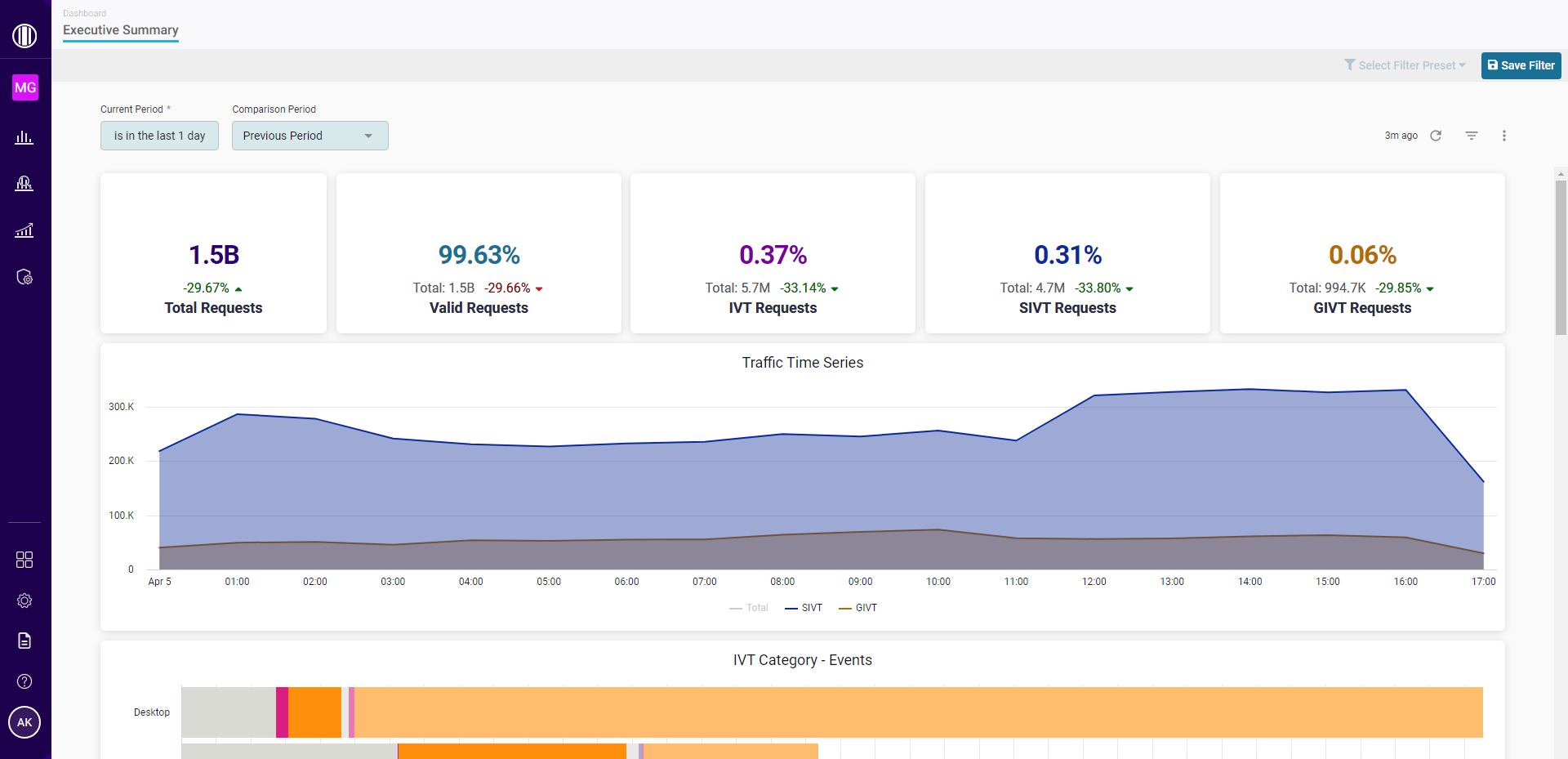MediaGuard Dashboard
MediaGuard is HUMAN’s pre-bid advertising tool for flagging fraudulent bid requests.
MediaGuard’s Executive Summary page provides an overview of your ad traffic in near-real time. In addition to the standard Executive Summary functionality shared across all HUMAN products, this page offers several elements specific to MediaGuard’s capabilities.
Filters
You can use filters to customize the data displayed on MediaGuard’s Executive Summary page. These filters include:
- Current Period: The time period for which traffic data will be displayed.
- Comparison Period: The time period to which current traffic data will be compared (as percentage-over-time trends.
For the Current Period filter, the is in the last constraint calculates time periods using calendar benchmarks rather than counting backwards from the date and time at which the filter is created.
For example, if you create a filter to show data within the past month, you will see data starting from the first day of the current calendar month rather than data from the past 30 days. As a result, you may see empty data for the remaining part of the month that has yet to occur. The same time period logic applies to days (which start at midnight), weeks (which start on Monday), and years (which start on January 1st).
To create week or month filters that count backwards from the current date and time, you can create a filter for is in the last <7 days> or is in the last <30 days> instead.
After you’ve adjusted these filters, select ![]() to update your MediaGuard data.
to update your MediaGuard data.
Traffic overview

MediaGuard’s Executive Summary page includes multiple breakdowns of the traffic data that meets the conditions of your applied filters.
Traffic metrics
A traffic breakdown by request category. These breakdowns include request percentages, request totals, and percentage trends over time.
- Total Requests: The total number of recorded requests during the selected time frame.
- Valid Requests: The percentage and number of requests that were determined to be valid.
- IVT Requests: The percentage and number of requests that HUMAN flagged as Invalid Traffic (IVT). This percentage is the combined total of Sophisticated IVT (SIVT) and General IVT (GIVT) requests.
- SIVT Requests: The percentage and number of requests that HUMAN flagged as Sophisticated IVT (SIVT).
- GIVT Requests: The percentage and number of requests that HUMAN flagged as General IVT (GIVT).
Any increase in the percentage of Valid Requests is highlighted in green, since this positively impacts the quality of your overall traffic. Any increase in the percentage of IVT, SIVT, or GIVT Requests is highlighted in red, since this negatively impacts the quality of your overall traffic.
Traffic Time Series
A graph that displays the total number of requests over time, as well as the number of these requests that were classified as SIVT and GIVT. You can hover over any point on the graph to view the timestamp and number of requests associated with that data point, or select any labels below the graph to show/hide that category’s data in the visualization.
IVT Category - Events
A chart that displays the IVT categories detected by HUMAN, broken down by the number of invalid requests per category that occurred on each platform.
You can hover over any section of the chart to view the number of requests associated with that platform and IVT category, or select any of the labels below the graph to show/hide that IVT category’s data in the visualization.
Supplier ID
A table with detailed information about the suppliers who drove the most invalid requests, with additional data about the percentage and number of requests that were categorized as IVT, SIVT, and GIVT.
Publisher ID
A table with detailed information about the publishers who drove the most invalid requests, with additional data about the percentage and number of requests that were categorized as IVT, SIVT, and GIVT.
IVT based on App ID
A table with detailed information about the applications that drove the most invalid requests, with additional data about the percentage and number of requests that were categorized as IVT, SIVT, and GIVT.
IVT based on Domain
A table with detailed information about the domains that drove the most invalid requests, with additional data about the percentage and number of requests that were categorized as IVT, SIVT, and GIVT.
Device Traffic
A chart that displays the number of requests by device type, as well as the percentage of Valid, SIVT, and GIVT requests associated with each device type’s total traffic. You can hover over any section of the chart to view the timestamp and number of requests associated with that device type and threat category, or select any of the labels below the graph to show/hide that threat category’s data in the visualization.